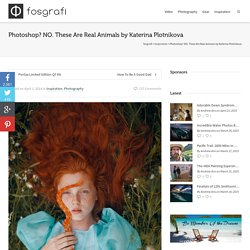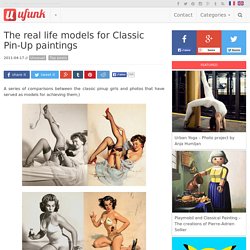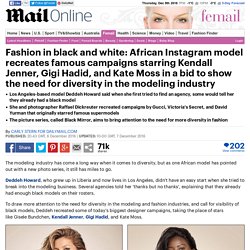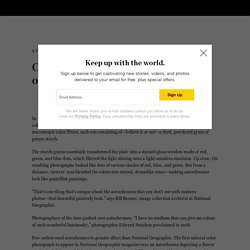

“A Show of Hands” (2020) (1935) Portrait of Amrita Sher-Gil. Fernande Barrey (~1910) U/ScummyWallows 'Iridescent' (2020) 50 Captivating Photos Of Girls Going To School Around The World. Photograph of an unknown woman taken by F. Holland Day (1907) Jad Ghorayeb "Untitled" (2017) (1937) Portrait of Frida Kahlo for VOGUE, by Toni Frissel. "Save Our Sisters" Campaign. (1907) Maricopa women gathering saguaro fruits, by Edward S. Curtis. (1917) Circassian girl in North Caucasus.
(1951) 'In Voluptas Mors' or 'Voluptuous Death' by Salvador Dali and Philippe Halsman. (1950) Ava Gardner [colorized] (1956) Anita Ekberg. Whimsical images by photographer Katerina Plotnikova. Katerina Plotnikova did something extremely amazing!

She used no photoshop! All poses and animals are real! (1909) Young Kenyan woman holding a Dik-Dik in Mombasa. (1912) Girl Scout Troop. (1909) Young Kenyan woman holding a Dik-Dik in Mombasa (Colorized) Sofia Ajram's Photostream. Untitled photograph taken by u/ccouilla (2016) (1938) Photo of unknown woman, by The Horst P. Horst. "Auto-Complete Truth" Campaign from UN Women. Here's a simple and powerful campaign idea from UN Women using real suggested search terms from Google's autocomplete feature.

Campaign creator Christopher Hunt, head of art for Ogilvy & Mather Dubai, offers this summary: “This campaign uses the world's most popular search engine (Google) to show how gender inequality is a worldwide problem. The adverts show the results of genuine searches, highlighting popular opinions across the world wide web.” Each ad's fine print says "actual Google search on 09/03/13. " While Google users in different countries are likely to get different results, a quick test shows that several of these suggested terms definitely come up in U.S. searches.
Since its creation, autocomplete has become a popular device for social debate and even inspired a recent epic visual from xkcd, but these ads do a stellar job driving home the daunting fact that enough people around the world share these vile opinions that Google has come to expect them. (1944) Angela Lansbury. "Domestic Bliss" By Susan Copich. Una artista, casada y madre de dos niñas, ha revolucionado el concepto de la tradicional fotografía de familia, con una serie de polémicas imágenes titulada Domestic Bliss (Felicidad doméstica).

Después de pasar años como una abnegada madre, prestando constantemente y casi de forma exclusiva atención a sus niñas, haciendo infinidad de fotografías en las que nunca jamás aparecía ella misma, a la ex bailarina Susan Copich se le ocurrió la idea de este proyecto fotográfico único, pensó que podía girar la cámara hacia sí misma, de recuperar su identidad, y de "mostrar una serie de honestidad emocional".
Cada una de las imágenes de la serie Felicidad Doméstica tiene lo que Susan llama una "vuelta de tuerca de las tinieblas". El toque tenebroso es su elemento más audaz, que desafía nuestra percepción normal de la felicidad familiar. (1937) "Our Lily, Arum Lily" by Stefan Lorant. The real life models for Classic Pin-Up paintings. A series of comparisons between the classic pinup girls and photos that have served as models for achieving them;) via.

(1989) Pamela Anderson. 8 Vintage Pics Of Carrie Fisher Promoting “Return Of The Jedi” In 1983. You’re probably aware of the metal “Slave Leia” bikini even if you’re not a Star Wars fan.

In 1983, Carrie Fisher brought it to light in “Return Of The Jedi.” The famous outfit also got a fair share of attention while the actress was promoting the movie with the Rolling Stone magazine beach shoot in the same year. There’re rumors that the famous costume could be “retired from the Star Wars IP for merchandise and marketing.” While they’re not confirmed yet, let’s have a look at these vintage photos! (1946) Marilyn Monroe modeling on the beach.
African Instagram model recreates famous campaigns starring Kendall Jenner and Gigi Hadid. The modeling industry has come a long way when it comes to diversity, but as one African model has pointed out with a new photo series, it still has miles to go.

Deddeh Howard, who grew up in Liberia and now lives in Los Angeles, didn't have an easy start when she tried to break into the modeling business. Several agencies told her 'thanks but no thanks', explaining that they already had enough black models on their rosters. To draw more attention to the need for diversity in the modeling and fashion industries, and call for visibility of black models, Deddeh recreated some of today's biggest designer campaigns, taking the place of stars like Gisele Bundchen, Kendall Jenner, Gigi Hadid, and Kate Moss.
Take two: Model Deddeh Howard has recreated several high-profile fashion campaigns, like this one starring Gisele Bundchen The new one: Deddeh wants to draw attention to the need for more diversity in the modeling industry Spot the difference? Seriously? Loaded: 0% Progress: 0% (1945) A German woman cries amongst the rubble after Allied air raids in Dessau.
(1941) Naked and humiliated woman is comforted by an older woman while an anti-Jewish mob surrounds them. (1930) Cheyenne maiden, by Edward S. Curtis. National Geographic's Antique Autochromes of Women. In 1907, brothers Auguste and Louis Lumière developed the first commercially viable form of color photography.

Their process, called autochrome, used glass plates coated with millions of microscopic color filters, each one consisting of—believe it or not—a dyed, powdered grain of potato starch. The starch grains essentially transformed the plate into a stained-glass window made of red, green, and blue dots, which filtered the light shining onto a light-sensitive emulsion. Up close, the resulting photographs looked like dots of various shades of red, blue, and green. But from a distance, viewers’ eyes blended the colors into muted, dreamlike tones—making autochromes look like pointillist paintings. "That's one thing that's unique about the autochromes that you don't see with modern photos—that beautiful painterly look," says Bill Bonner, image collection archivist at National Geographic.
Photographers of the time gushed over autochromes. (1949) Audrey Hepburn with chorus girls from the show "Sauce Tartare" on the roof of London's Cambridge Theatre. Untitled by Sofia Ajram.